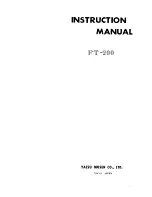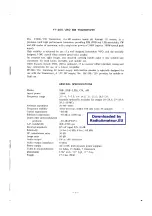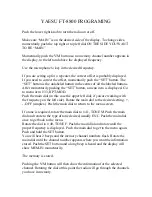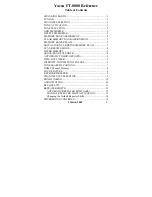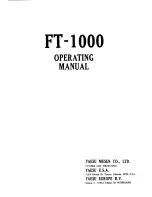
for $40, go out to RadioShack, buy
an SPL meter, load it with a nine-
volt battery, learn how to use it,
actually use it, and then put it in a
drawer to remain untouched for
years—if in fact you ever use it
again or even remember it’s there.
Also missing from the AVR 630
is room EQ. However, it would be
unjust to say that Harman hasn’t
got this angle covered. At least for
the time being, the company’s
institutional point of view is that
EQ is best limited to bass frequen-
cies. For that purpose, Harman’s
Infinity brand offers the CWS-10
and SW-12 subwoofers with adjust-
ments for EQ frequency, level, and
width—and the street-price dif-
ferential would just about pay for
the sub. For more information on
why equalizing frequencies above
250 hertz might be a bad idea, read
the white paper from Meridian
(not part of the Harman empire):
www.meridian-audio.com/w_paper/
Room_Correction_scr.pdf
.
The Harman sound is as familiar
to me as my sisters’ voices. The
slightly warm, carefully sculpted
midrange is designed for maximum
intelligibility. Dynamics are better
than you’d expect, given the man-
ufacturer’s conservatively quoted
75-watts-per-channel power rating.
Most manufacturers quote at least
100 wpc even for their lowest
priced weaklings, but this one
doesn’t insult the intelligence with
magic numbers; instead, H/K pro-
vides an “all channels driven” spec.
A 41-pound receiver with ventila-
tion holes on three sides should
muster a fair amount of current.
All surround receivers—includ-
ing the four reviewed here—are
subject to some degree of clipping
when asked to produce more
power (aka higher volume levels)
than they’re capable of. Even if you
Harman/Kardon receivers is the
manner in which they clip on
relentless material like
The Matrix
Revolutions
. Run this receiver near
the top of its volume capability,
and it maintains its character. The
sculpted midrange doesn’t sud-
denly lose its shape.
are routing all bass below 100 Hz
to your subwoofer (I actually used
a more-taxing 80-Hz crossover),
feeding seven woofers and seven
tweeters will challenge a power
supply that’s small enough to
share a box with a lot of other cir-
cuitry. The secret strength of
> Five channels driven into 8-ohm loads:
0.1% distortion at 79.7 watts; 1% distortion at
93.3 watts
> Analog frequency response in direct mode:
–0.35 dB at 10 Hz; –0.12 dB at 20 Hz; –0.13 dB at
20 kHz; –0.72 dB at 50 kHz.
> Analog frequency response with signal processing:
–0.85 dB at 10 Hz; –0.27 dB at 20 Hz; –0.45 dB at
20 kHz; –28.64 dB at 50 kHz.
This graph shows that the AVR 630’s left channel,
from CD input to speaker output with two channels
driving 8-ohm loads, reaches 0.1% distortion at
84.6 watts and 1% distortion at 100.6 watts. Into
4 ohms, the amplifier reaches 0.1% distortion at
146.9 watts and 1% distortion at 170.8 watts.
Response from the multichannel input to the
speaker output in direct mode measures –0.23 dB
at 10 Hz, –0.08 dB at 20 Hz, –0.12 dB at 20 kHz, and
–0.66 dB at 50 kHz. THD+N from the amplifier was
less than 0.027% at 1 kHz when driving 2.83 volts into
an 8-ohm load. Crosstalk at 1 kHz driving 2.83 volts
into an 8-ohm load was –84.29 dB left to right and
–83.15 dB right to left. The signal-to-noise ratio with
2.83 volts driving an 8-ohm load from 10 Hz to 24 kHz
with “A” weighting was –96.52 dBrA.
From the Dolby Digital input to the loudspeaker
output, the left channel measures –0.20 dB at 20 Hz
and –0.26 dB at 20 kHz. The center channel measures
–0.17 dB at 20 Hz and –0.45 dB at 20 kHz, and the
left surround channel measures –0.18 dB at 20 Hz
and –0.39 dB at 20 kHz. From the Dolby Digital input
to the line-level output, the LFE channel is –0.10 dB
at 20 Hz when referenced to the level at 40 Hz and
reaches the upper 3-dB down point at 109 Hz and
the upper 6-dB down point at 116 Hz.—
MJP
0.0001
10
0.0002
0.0005
0.001
0.002
0.005
0.01
0.02
0.05
0.1
0.2
0.5
1
2
5
%
25
200
50
75
100
125
150
175
W
HT Labs Measures: Harman/Kardon AVR 630
HARMAN/KARDON AVR 630
AT A GLANCE
>
CONNECTIONS:
IIn
np
pu
utts
s::
Video: component (2),
S-video (5), composite (5)
Audio: coaxial digital (3), opti-
cal digital (3), eight-channel
analog (1), stereo analog (7)
O
Ou
uttp
pu
utts
s::
Video: component (1),
S-video (3), composite (3)
Audio: coaxial digital (1), opti-
cal digital (1), stereo analog (4),
preamp (1), main room (2),
second zone (2)
A
Ad
dd
diittiio
on
na
all::
A-BUS (1), RS-232 (1), infrared
jack (2), switchable front-
panel jacks may serve as
inputs or outputs
>
FEATURES:
Processing Modes:
Dolby: Digital 5.1, EX, Pro Logic II,
Virtual Speaker, Headphone
DTS: DTS, ES, 96/24, Neo:6
Other: HDCD, Logic 7, VMAx, MP3
THX Certification:
No
Audio D/A Converter:
Cirrus CS 42528
Number of Amp Channels:
7
Amp Power (per channel):
75 watts, into 8 ohms, all ch. driven
Amp Frequency Response:
10 Hz—130 kHz
Dimensions (H x W x D):
6.5 x 17.3 x 17.1
Weight (in pounds):
41
These listings are based on the manufacturer’s stated specs; the HT Labs box below
indicates the gear’s performance on our test bench.



